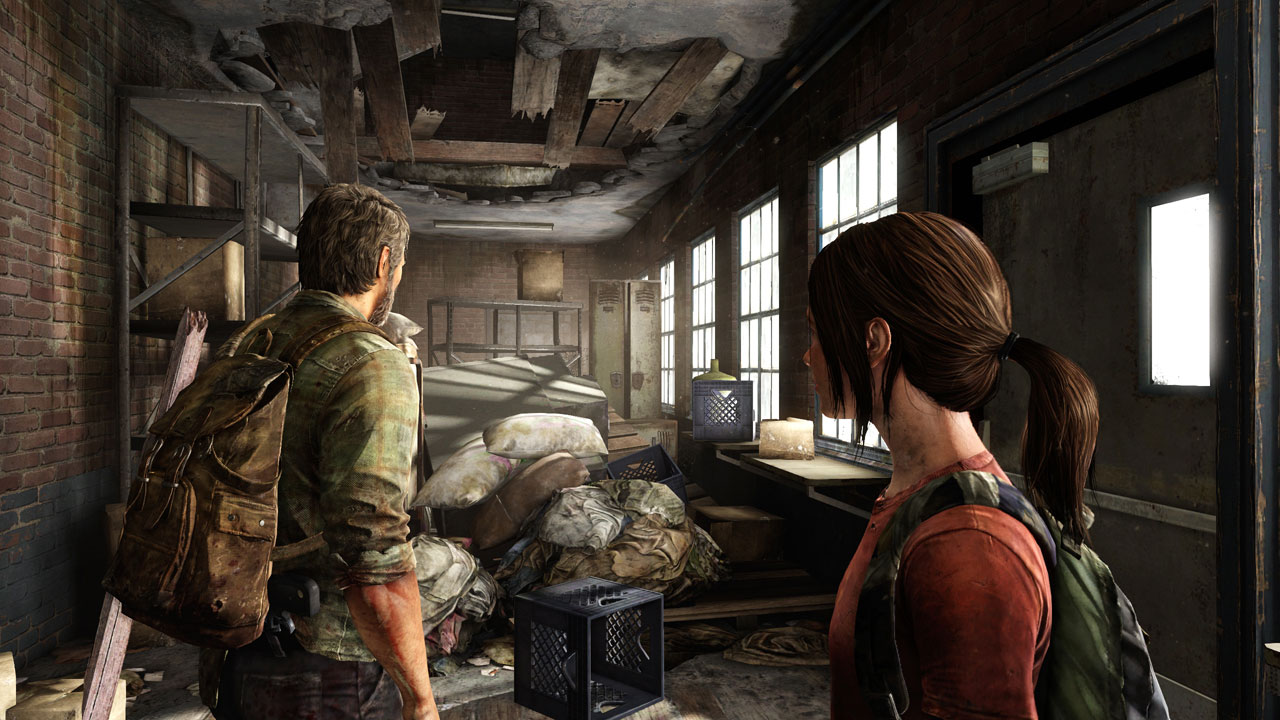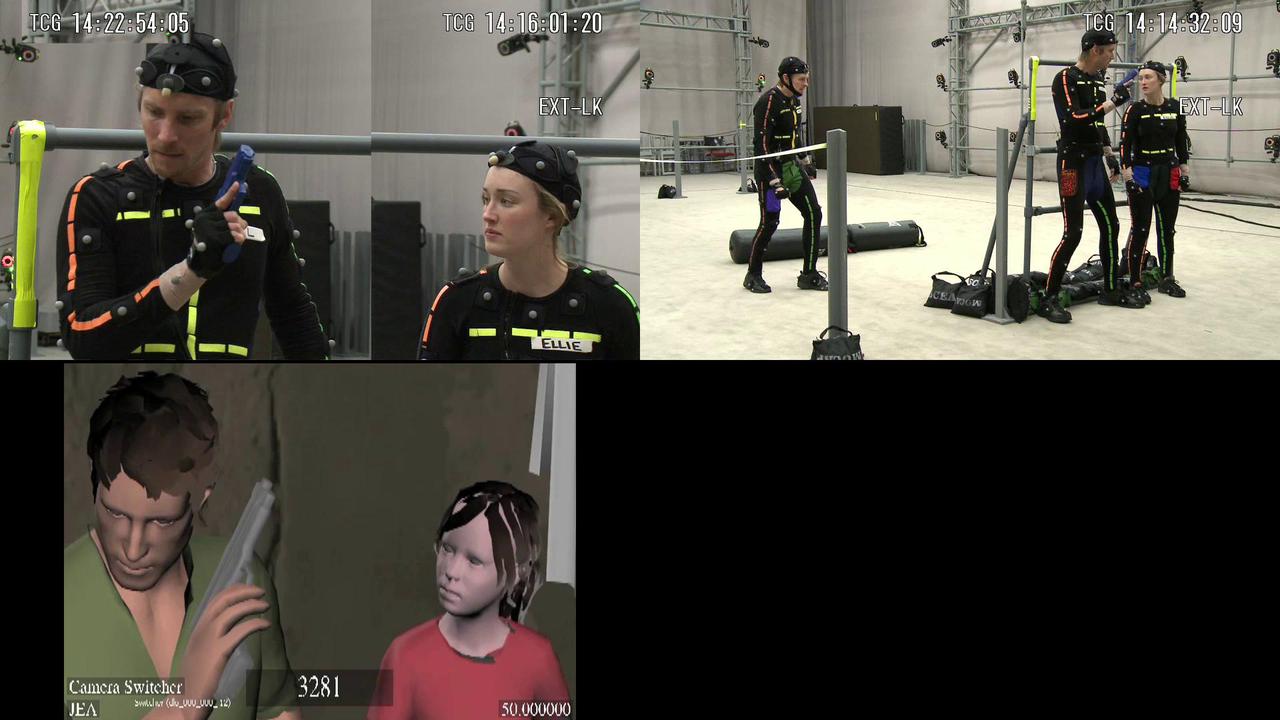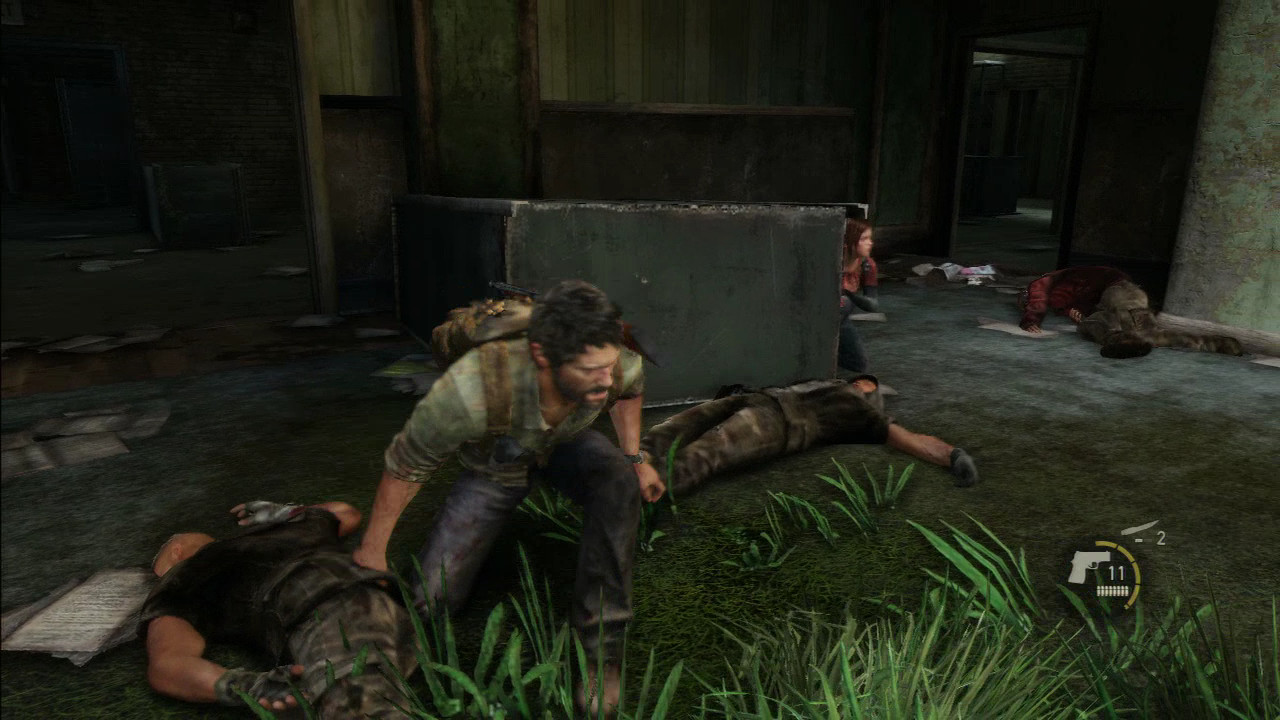Reviewed by: Jamaal Ryan
I put my ear to the ground and listened; about half a dozen Runners were located on the upper level of a college campus building. As one of the more briskly Infected was making his rounds about the hall, I attempted to stealth kill him from behind, not anticipating that his spontaneous head snap would blow my cover. Right when he spotted me, he let out a hall echoing howl alerting his buddies that it was time to eat. I ran.
Sprinting down the stairs, I managed to hurl a nail bomb on the staircase right before I took cover behind a wall. Two of the Runners ran over it; they could run no more. One slowed down searching the bottom lobby for me. As I was nestled in the corner, I drew my bow and killed her silently. I listen again and spotted two on the stairs and one in the hallway on the second level. I lit up a Molotov, and scorched the two on the flight of stairs. Then the last came searching for me as I hid again, and right when his back was turned, I took him down and stepped on the floor through his skull.
This all occurred just moments after I listened to an exchange between Ellie and Joel peacefully strolling through the abandoned campus on horseback, as Ellie expressed her curiosity of college life while Joel explained it in the best way he could.
It’s the coexisting moments like these, having to fight for your life and reflecting on how far the world has turned, being some of the many reasons why I love The Last of Us so much. No one dared to disturb me while I played. You couldn't provide commentary on it, you couldn't ask me what was happening, and you sure as hell couldn't request me to do anything that required me to remove myself from it. Any of the above would have granted you a quick “Shhh!!”
The Uncharted series’ studio takes a left turn in The Last of Us. It’s a grim, desperate, and powerful story, a powerful gameplay experience that encapsulates us in one of the most definitively engrossing video games in history.
The Last of Us sets its achingly morose tone immediately. Twenty years after human kind’s greatest global epidemic turning people into fungal infected monsters, we meet Joel, a leather skinned pepper greyed survivor that has done things he never wishes to speak of to keep himself alive. This existence of desperation and survival has hardened him as he has been forced to divorce himself away from the life that once was to maintain the life he has now.
Joel has been burdened with the job of transporting Ellie, a wide eyed and foul mouthed fourteen year old who was born into this post civilization world knowing no other life outside of quarantine zones, looting predators, and the mindless carnivorous Infected. Ellie is exactly what you would expect from a byproduct of a dystopian survivalist society. She's spunky, potty mouthed, honorable yet naive, and extremely capable and aware of the dangers she faces but too young to process them fully by juxtaposing her experiences next to a world 20 years dead.
In its grand scheme, The Last of Us doesn’t attempt to weave a meta back story, muddled with chunks of science and conspiracy that would need to be dissolved for consumption. Instead, you’ll find all that caked into the contextual environment so long as it serves the story purpose. What Naughty Dog delivers is perhaps the most empathetic growth between two individuals. The ebb and flow between Joel and Ellie steal the show as the dynamics of each situation in a world that’s trying to kill them at every turn, bring them closer and closer together with both showing how they care for one another in the only way they can. This is The Road meets Children of Men, focusing on Ellie, Joel, and even the characters that they come in contact with.
But even as you’re alone, desperately scavenging for items to sustain your survival, you’ll come across more natural droplets from the personal stories of those who have once lived, and those who have tried to survive: a collage of pictures in a college dorm, a myriad of posters in a teen’s bedroom, a daily log after the outbreak, a letter to a loved one in hopes to see them soon.
What happened here?
Naughty Dog has once again set an all new benchmark in video game performances. Joel is Troy Baker’s Captain Martin Walker, Nolan North’s stellar performance from Spec Ops: The Line, and his gruff southern drawl here easily bests Baker’s previous role as Booker Dewitt in this year’s other game of the year contender, Bioshock Infinite.
But he’s hardly the sole stand out performer in The Last of Us. Growing Pains’ Ashely Johnson brings out Ellie’s unapologetic confrontational character along with her amusing curiosity and delivers arguably the best moments in the game’s entirety. Annie Wersching plays a headstrong Tess who commands each scene she shares with any of the game’s cast. Every performance is at the top of their game; there are moments that will warm your heart, some will make you angry, enough will deeply upset you, and others will even disturb you. This is one of the many ways that The Last of Us trumps anything the developer has ever done, anything that any other game has ever done.
Where the magic happens.
The overarching harrowing sense of survival saturates how you play The Last of Us. For most, this will be a primarily a stealth game, as you and your companions spend enough time crouched down to build arthritis in their knees while sneaking around other humans and the Infected, albeit some of your partners’ immersion-breaking movement in front of enemies. This unseen approach becomes evidently more significant as no encounter allows you to leave alive without preparation.
All of your actions matter in The Last of Us. It is imperative to be proactive and take everything into consideration. The scarcity of the ammo makes every individual bullet its own resource as you’ll be fortunate to find more than two rounds at a time. Item crafting and equipping happens in real-time, leaving Joel completely defenseless to enemy attacks. And melee weapons degrade as does Joel’s health, which is only mended with the consumption of food and the use of discovered or crafted health kits. Everything means so much more because The Last of Us “item-starves” you. What you see is what you get, and you’d better make it count for the long haul.
"I am running out of luck."
These survival based systems have a direct influence on how you use your inventory: a glass bottle for a distracting or direct-projectile advantage, a brick or a pipe for a brutal upper hand, a neck-stabbing shiv or a bow and arrow for a covert approach, a Molotov or nail bomb for radial damage. All of the equipment in your possession is useful in their unique and essential ways, and you’d be best to utilize all of them to your situational advantage.
Because of this, The Last of Us makes no apologies as to how much it demands from you, and the first rule of combat knowing where your enemies are. Come prepared and activate Joel’s listening ability which will outline your foes through walls so long as they’re moving. But make no mistake, just as you can locate your enemies by sound, they will make attempts to find you if you make any noise.
Avoiding the blind echo-locating Clickers, the self mind-f**king Runners, and the collaborative humans brings the game’s pace to a painfully engrossing tempo as even strewn-about bottles and other noisy unused items should be approached with caution. Yet the game is designed well enough to adaptably switch from stealth to action if things go awry. Whether you want to be lethal or nonexistent, you have to think intelligently, come prepared, and be very, very careful.
"Now, you see what you made me do ‘cause you ran right in front of the guy?"
When things go to s**t, you’ll have to fight. Facing two enemies is a challenge, but going up against anything more than three is a true test of your skills. The AI is shockingly unpredictable. Once their routine is disturbed, they break their route and free-roam, forcing you to accommodate spontaneity in your scrupulous approach. They change direction and patterns, look over their shoulder when you least expect it, and randomize their search all within a broadened patrol radius. Though at other times, where they may appear to be oblivious to your whereabouts by not venturing into your general location, this is deliberately done to pull you out of your guerrilla-ambush advantage and press you to take more risks. And taking risks is always an uncomfortable proposition in The Last of Us.
Part of the reason why facing enemies is so challenging is also what many would call as the game’s fault. Aiming feels stiff and contrived, but The Last of Us’ gunplay also succeeds at purposeful restriction. Pointing firearms doesn’t have the proper acceleration and smooth directional orienting that conventional shooters have; in fact, they feel ‘worse’ than even Uncharted 3’s original build. But this was design by choice, not underperformed execution, which is similar to the idea behind games like the original Resident Evil’s handicapped navigation inflating the survival horror feel. I absolutely appreciate the constricted aiming. It brings you right down to the same level of poor accuracy the AI is capable of. Their aim is bad, but so was mine. When they shot back, it felt like I was shooting actual humans; when the less human charged at me, it was vastly more terrifying.
Oh s**t! Oh s**t! Oh s**t OH S**T!!
In an arms-length admirable claim, it’s The Last of Us’ depiction of violence that’s the bloody, sour cherry on top. It mixes the Naughty Dog’s industry pioneering visuals with an uncomfortable pitch of sound design alongside its emphasis on post-societal realism. We’ve seen men thrown through meat-grinders in games like Gears of War, but a hacked decapitation, a string or splat of blood, an explosively removed limb, a pair of eyes dimming to the loss of oxygen, all create this world that not only we don’t want to be a part of, but sometimes one we can’t bear to look at. Even here, along with the story, the setting, and the characters, it all boxes us into this agonizing, captivating masterpiece.
"Hey, I got somethin’ for yah that’ll blow your mind."
The story of Joel and Ellie’s adventure is a truly beckoning tale as it stands; but there’s another story to experience in The Last of Us, your very own.
Enter this year’s biggest multiplayer surprise, Factions. Each individual taking up to arms in Factions multiplayer becomes a leader of their own survivor camp. Matches are decided on eliminating the opposing team, but your goal is to gather enough supplies – awarded by in-game action – to keep your camp from becoming hungry or sick. Taking on that responsibility adds to the mirrored play style of patience and execution through crafting, sneaking, and positioning that The Last of Us’ story imposes upon players.
In fact, the level of tension in engaging enemy players can even surpass those found in the single player component. In one match as the only surviving member of my team, I evaded my pursuers as four flashing red dots closed in on my position. In preparation for their attack, I made my way across the map while taking small windows of opportunity crafting bombs, shivs and restoring my health up until I awaited the inevitable final encounter. I was overwhelmed with anxiety so much so that my chest pounded until it hurt, something that has never happened to me in multiplayer game before. Even though I was out numbered, I knew that there was a possibility that I stood a chance, as death comes quickly in Factions. It was an unforgettable moment for me that will always be a part of what defines The Last of Us' multiplayer.
You’ll be afraid for yourself, and the lives that rely on your success.
Another part that signifies what Factions is are the times when the lives that depend on you need you most. Every week, your camp will be faced with dangers that will put a percentage their population at stake. For preparation, you’ll be given three days (spread across three matches) to complete challenges that get increasingly difficult by the week. Each task changes your play style dramatically as they challenge you to wiggle outside of your rigid comfort zone which compounds upon the risks you already take in multiplayer. In the end, lives will be lost, but it’s up to you to make that number less catastrophic.
This bleak sense of responsibility puts an emphasis on selflessness like I've never seen before in a multiplayer shooter. Killing another player only means something if I could supply my people enough to stay healthy, only if I can continue to read the commentary and updates on my group members letting me know how they're how they're doing, if things are looking up for faceless names like Aiden Tanaka, or if Kevin Diaz is having a nervous breakdown, and most importantly, can they survive a raid attack. It tells a story within multiplayer that will drive you to do better; not for yourself, but for the sake of dozens of others.
Bottom Line
Each time I powered down my PS3, I had to take a moment to regain my composure. If the sun was out, I took a few seconds to appreciate it; if it was late at night, I’d wake up my computer to consume something from the real world. That’s what The Last of Us can do to you, tag team you by creating dreary existence of constant worry and tension, “When am I going to find some alcohol to craft a health kit… What am I going to do if this guy sees me…Can I trust these characters…What’s going to happen to Ellie and Joel?”
This game, this experience, is the best example of demonstrating how video games create safe spaces for us to endure unpleasant emotions. Everything Naughty Dog has designed was meant for that purpose.
The Last of Us is easily the best adventure game I've ever played. But subjectively speaking, it may very well be the best game I've ever played.
+ Powerfully driven emotional character development
+ Desperately intense gameplay of survival
+ The best performances you’ll ever see in a video game
+ Multiplayer that encapsulates everything about the story
SCORE: A+












No comments
Post a Comment